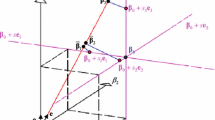Abstract
This paper introduces new strict error bounds of computed outputs of interest for time-dependent nonlinear problems in quasi-statics as well as in dynamics. All sources of errors, including modeling errors, are taken into account. Therefore, such error bounds are also suitable tools for analyzing various approximations, particularly in dynamics. Small-displacement problems without softening, such as (visco)plasticity problems, are included through the classical thermodynamics framework involving internal state variables; the material models are not necessarily standard.
Similar content being viewed by others
References
Babus˘ka I and Strouboulis T (2001). The finite element method and its reliability. University press, Oxford
Ladevèze P and Pelle J-P (2004). Mastering calculations in linear and nonlinear mechanics. Springer, NY
Ladevèze P and Oden J-T (1998). Advances in adaptative computational methods in mechanics. Elsevier, Amsterdam
Wiberg NE, Diez P (eds) (2006) Special Issue. Computer methods in applied mechanics and engineering
(2003). Error controlled adaptive finite elements in solid mechanics. Wiley, New York
Eriksson K, Estep D, Hansbo P and Johnson C (1995). Introduction to adaptive methods for partial differential equations. In: Isereles, A (eds) Acta numerica., pp 105–159. Cambridge University Press, Cambridge
Becker R and Rannacher R (1996). A feed-back approach to error control in finite element methods: basic analysis and examples. East-West J Numer Math 4: 237–264
Rannacher R and Sutt meier FT (1998). A posteriori error control and mesh adaptation for finite element models in elasticity and elasto-plasticity. In: (eds) Advances in adaptative computational method in mechanics., pp 275–292. Elsevier, Amsterdam
Ladevèze P, Rougeot P, Blanchard P and Moreau JP (1999). Local error estimators for finite element linear analysis. Comput Methods Appl Mech Eng 176: 231–246
Strouboulis T, Babus˘ka I, Datta D, Copps K and Gangaraj SK (2000). A posteriori estimation and adaptive control of the error in the quantity of interest - Part 1: A posteriori estimation of the error in the Von Mises stress and the stress intensity factors. Comput Methods Appl Mech Eng 181: 261–294
Cirak F and Ramm E (1998). A posteriori error estimation and adaptivity for linear elasticity using the reciprocal theorem. Comput Methods Appl Mech Eng 156: 351–362
Prudhomme S and Oden JT (1999). On goal-oriented error estimation for elliptic problems: application to the control of pointwise errors. Comput Methods Appl Mech Eng 176: 313–331
Parès N, Bonet J, Huerta A and Peraire J (2006). The computation of bounds for linear-functional outputs of weak solutions to the two-dimensional elasticity equations. Comput Methods Appl Mech Eng 195(4–6): 406–429
Peraire J and Patera AT (2006). Bounds for linear-functional outputs of coercive partial differential equations; local indicators and adaptive refinements. In: (eds) Advances in adaptive computational methods in mechanics., pp 199–216. Elsevier, Amsternam
Greenberg HJ (1948). The determination of upper and lower bounds for the solution of Dirichlet problem. J Math Phys 27: 161–182
Washizu K (1953). Bounds for solutions of boundary value problems in elasticity. J Math Phys 32: 117–128
Ladevèze P (2006). Upper error bounds on calculated outputs of interest for linear and nonlinear structural problems. Comptes Rendus Académie des Sciences - Mécanique, Paris 334: 399–407
Ladevèze P and Moës N (1998). A new a posteriori error estimation for nonlinear time-dependent finite element analysis. Comput Methods Appl Mech Eng 157: 45–68
Chamoin L, Ladevèze P (2006) Bounds on history-dependent or independent local quantities in viscoelasticity problems solved by approximate methods. Int J Numer Methods Eng; online, DOI: 10.1002/nme. 1978
Chamoin L, Ladevèze P (2007) A non-intrusive method for the calculation of strict and efficient bounds of calculated outputs of interest in linear viscoelasticity problems (submitted)
Ladevèze P (1999). Nonlinear computational structural mechanics - new approaches and non-incremental methods of calculation. Springer, New York
Bui HD (1993) Introduction to inverse problems in material mechanics. Eyrolles Paris (in french)
Ladevèze P, Moës N and Douchin B (1999). Constitutive relation error estimations for (visco) plasticity finite element analysis with softening. Comput Methods Appl Mech Eng 176: 247–264
Author information
Authors and Affiliations
Corresponding author
Rights and permissions
About this article
Cite this article
Ladevèze, P. Strict upper error bounds on computed outputs of interest in computational structural mechanics. Comput Mech 42, 271–286 (2008). https://doi.org/10.1007/s00466-007-0201-y
Received:
Accepted:
Published:
Issue Date:
DOI: https://doi.org/10.1007/s00466-007-0201-y




